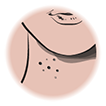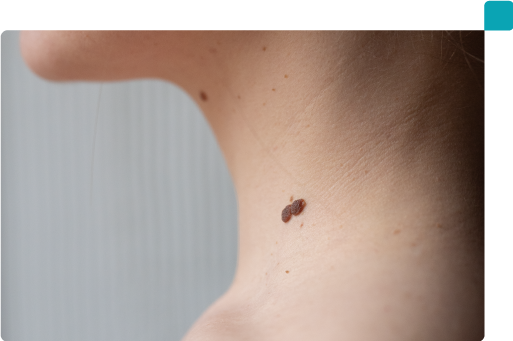Condition
Benign Skin Lesion
Benign skin lesion is a non-cancerous skin abnormality or growth that can occur anywhere on the body. Most of the time, these lesions are harmless and do not require treatment unless they cause symptoms such as discomfort or itching.
Types of Benign Skin Lesion

Seborrheic
Keratosis

Skin Tags

Cherry
Angioma

Solar
Lentigo

Sebaceous
Hyperplasia

Syringoma

Milia

Xanthelasma
What causes it
What causes Benign Skin Lesion?
Seborrheic Keratosis
Seborrheic Keratosis is the most common benign skin tumor in the elderly population. It has a waxy, scaly and raised appearance and is usually black or brown. Areas of the body such as the face, chest, shoulders, back. The precise cause of seborrhoeic keratosis is not known.
Skin Tags
Skin tags are soft, flesh coloured, pedunculated benign growths commonly found at skin folds such as the eyelids, neck, armpits and groin area. The precise cause of skin tags is not known.
Cherry Angioma
Cherry angiomas(red moles) contain blood vessels, hence the red colour. It can be found on any part of the body, usually the face and chest. The direct cause of cherry angiomas is unknown. However, research has identified several factors that can cause cherry angiomas to appear which are aging, pregnancy(hormones) and genetics.
Solar Lentigo
Solar lentigo(age spot) is a flat hyperpigmented patch on the skin that is induced by sun exposure. When part of our skin is excessively exposed to sun, the area causes accumulation of melanin which in turn causes a brown discoloration of the area. Solar lentigo is usually seen in older fair-skinned people.
Sebaceous Hyperplasia
Sebaceous(oil) hyperplasia is caused when the sebaceous glands become overactive and produce too much oil which can be trapped under the skin. Although the condition can impact anywhere on the body, it is most common on facial skin.
Syringoma
Syringoma is caused by the overgrowth of cells from sweat glands (eccrine glands). It typically appears as small, firm flesh-coloured-to-yellowish bumps in small clusters on the skin. The most common locations for syringomas are upper cheeks, lower eyelids, armpits, chest and genitalia (penis or vulva).
Milia
Milia occur when dead skin cells do not slough away and become trapped under the new skin. It can also happen because of skin damage from blisters, an injury, burns, or sun exposure and long-term use of steroid creams. Milia typically appear as small, white bumps in clusters on the eyelids, nose and cheeks.
Xanthelasma
Xanthelasma is a soft, yellowish, fatty deposit that forms under the skin and is usually associated with high blood cholesterol. It is more common in women and among people whose families are from Asia or the Mediterranean.
Removal is absolutely an option for benign skin lesions, especially if it is causing pain, irritation, discomfort or even for cosmetic reasons. Removal technique must have excellent clinical efficacy and favourable cosmetic outcomes.

Treatment Options
BSL Removal is a procedure that uses heat from mild electric current to remove non-cancerous skin lesions or abnormal growth from different parts of the body. The heat will cause the targeted area to dry out and eventually fall off. The skin will then continue to heal and new skin will form over the wound.
Similar Conditions
From around the age of 25 the first signs of aging start to appear and become noticeable on the skin. Over time, the skin no longer looks as plump and smooth as it once did.
Skin pigmentation disorder affects the color of the skin and is caused by excess melanin production. It can occur in small patches, cover large areas or affect the entire body.
Schedule A Consultation
Being results driven, GEM Clinic provides FREE consultation personally by our doctors to assess client's concerns. Our doctors will determine the best suited treatment to deliver the most optimal results for you!